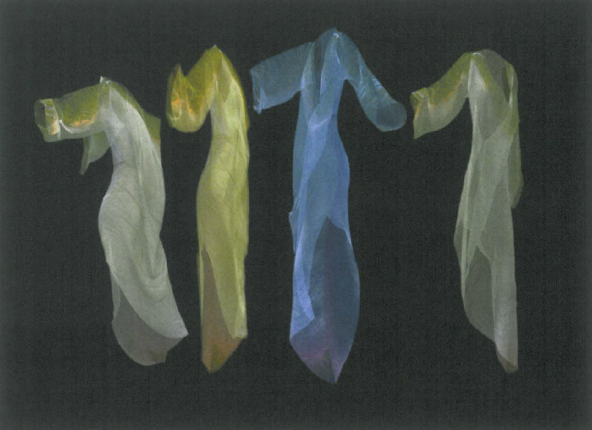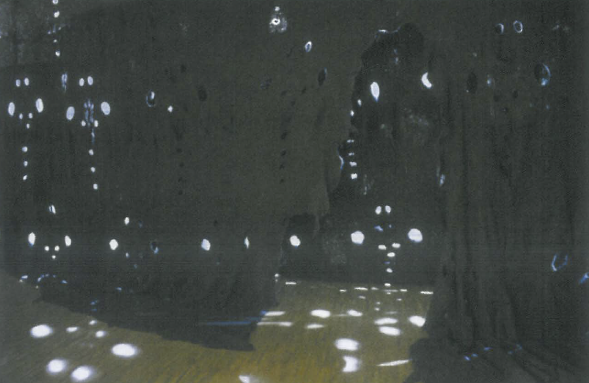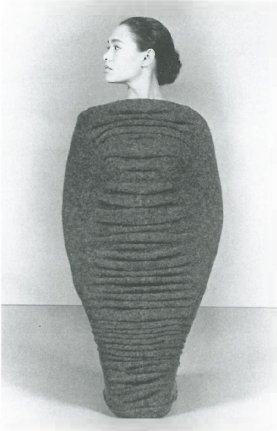
Initiated by the Textile Exchange Project in partnership with the Curtin University of Technology, The Space Between focused on the 'new creative and theoretical potentialities that have emerged from the blurring of boundaries between art, fashion, textiles and design.' Keynote lectures by Reiko Sudo, Maria Blaisse and Tissue Culture and Art set the tone for a diverse collection of presentations from artists, theorists, academics and curators. Rieko Sudo, director of the celebrated Japanese textile company Nuno, discussed the careful balance between tradition and technology which Nuno has long maintained with its innovative woven textiles. Tissue Culture and Art, a Perth based artistic research and development project, broadened the definition of the very term textile with their discussion of 'partial-life' membranes. TC and A's most recent project Victimless Leather suggests that future garments could be created from a semi-living membrane of cells which will eventually offer us a literal second skin.
The final keynote by the Dutch designer Maria Blaisse could not have taken a more different tone. Known for her innovative work with rubber and synthetic materials, Blaisse offered insight into her design processes and the origins of the deceptively simple forms she has developed for fashion, theatre and dance. Marie O'Mahony, author of Cyborg, the Man Machine, chaired a plenary session, which felt much more like the fourth keynote of the conference. Contextualising many of the themes discussed and focusing on the role of technology in the future of textile design, O'Mahony's lecture would have made an excellent opening keynote but regrettably did little to sum up the specific debates generated by three packed days of presentations and exhibition viewing in Perth.

Conference papers were presented by curators, scholars, artists and researchers in a refreshing range of styles from the informal to the academic. The 'space between' was evident in the variety of disciplinary frameworks which ranged from the scientific to the historical and effectively captured the textile in its multiplicity of origins and applications. Innovative presentations such as Jane Harris and Bernard Walsh's Virt'uous Dress created a literal dialogue between the two presenters who were physically separated by the series of images they projected. The ensuing 'conversation' between the two effectively captured the spaces and differences in interpretation between subject and object, maker and viewer, artist and critic. Sandy Black's Surface and Form: towards a topology of three dimensional fashion knitwear drew connections between the concepts of geometric topology (simplified for the audience in the example of London's underground map) and the attributes of knitwear to suggest that knitwear inhabits a space that is a hybrid not only of fashion, craft and design, but also maths and technology.
In addition to the lecture halls of Curtin University, a group of presenters elected to exhibit artwork on the second floor of the Perth Institute of Contemporary Art. A series of informal presentations by the exhibiting artists filled the first afternoon of the conference schedule. Video installations such as Nicola Naismith's mesmerizing Video Triptych projected images that intentionally confuse the boundaries between hand and machine production through imagery that ambiguously references both. Departing from the more traditional structuring of a conference, the series of visual presentations offered artists the opportunity to present and discuss artwork in the gallery setting for which it was conceived, rather than talk about artwork under the often forced parameters of the conventional lecture.

The extent of additional events organized to coincide with the conference left one with the luxury of far too much to choose from. Two exhibitions at the John Curtin Gallery explored international and specifically Australian textile related art. Taking the name of the conference, The Space Between included works by a strong international selection of names including Caroline Broadhead, Reiko Sudo, Jane Harris, Lucy Orta, and Maria Blaisse. In the adjacent gallery the 15th Tamworth Fibre Biennial 'Material Witness' focused specifically on Australian artists working with fibre and textiles. Maria Blaisse had a substantial retrospective at the Perth Institute of Contemporary Arts that included photographs, several videos, and a floor strewn with various forms which you were (carefully) encouraged to don and explore in motion. A catwalk fashion show occurred on the second evening of the conference and drew what looked to be a healthy blend of the Perth fashion savvy and slightly jet lagged conference participants. A further five exhibitions were mounted within walking distance of the conference hotel in downtown Perth, as well as a series of exhibitions in Fremantle for the closing events of the conference. Seven Sisters: Fibre Works Arising from the West was the most local in nature, exhibiting a long term collaboration between indigenous and non-indigenous fibre artists living in the west of Australia. Perhaps the most innovative effort to capture 'the space between' was Per Square Metre a project that took over ten store fronts of retail spaces in downtown Perth to create site specific textile themed installations which touched upon the commercial reality of the textile.
The Space Between did much to stimulate dialogue between art, fashion, textiles and design. The considerable efforts by the conference organizers to bring participants to the spaces between the lecture hall and shop window, catwalk and white cube effectively disrupted the ever-thinning borders between them. The Space Between suggests that an interdisciplinary approach to the textile is its future.












